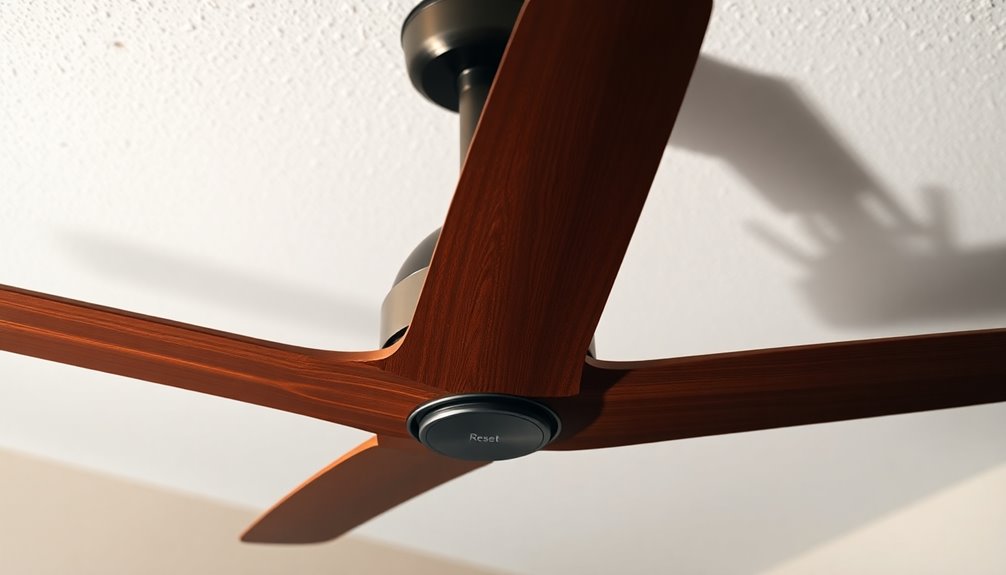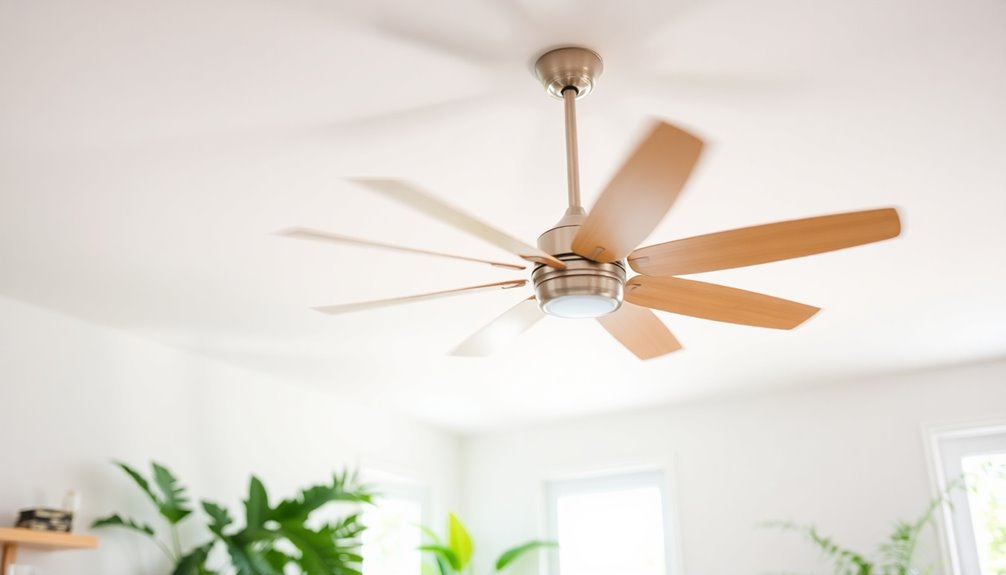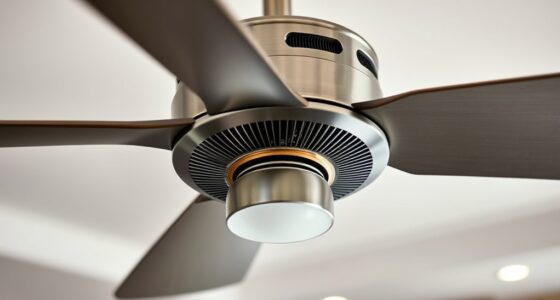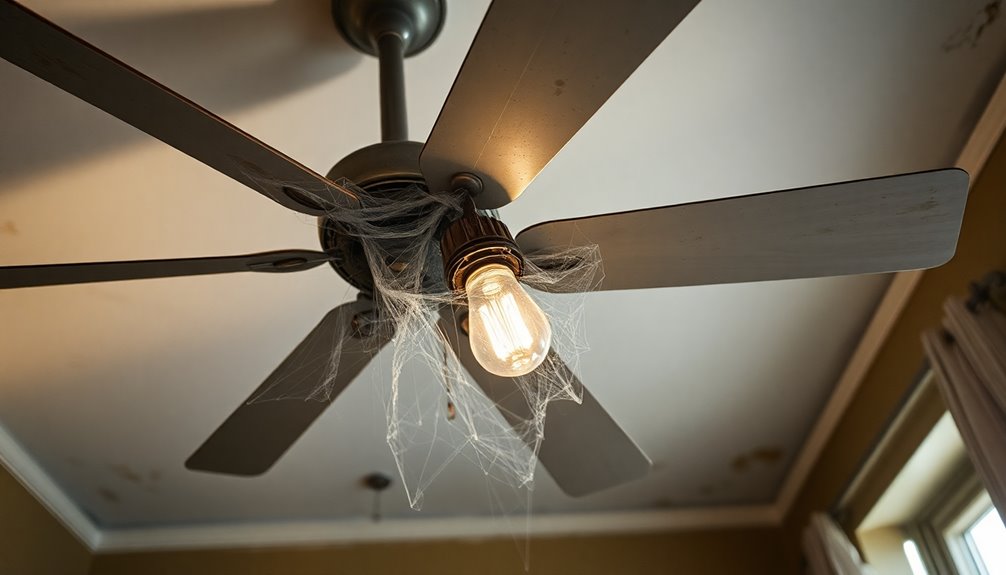Yes, most ceiling fans do have a reset button. You'll usually find it in the battery compartment of the remote or on the fan itself. This button is essential for fixing electronic glitches or connectivity issues. To reset, simply press and hold the button for a few seconds. If your fan still isn't responsive, consider power cycling it by turning it off at the wall switch for about 30 seconds. Regular maintenance can also enhance performance. If you're curious about other troubleshooting tips or specific models, you might want to explore further.
Key Takeaways
- Many ceiling fan remotes include a reset button located in the battery compartment, though its placement varies by brand and model.
- The reset button may be integrated with other buttons, so consult the manufacturer's manual for specific instructions.
- To reset the remote, press and hold the reset button for 5-10 seconds until you see flashing lights.
- Power cycling the fan can also help reset its internal memory, improving performance and resolving issues.
- Regular maintenance, including checking for a reset button, can prevent functionality problems with ceiling fans.
Understanding the Need to Reset

Sometimes, you may find that your ceiling fan remote isn't working as it should. This can be frustrating, especially when you just want to adjust the speed or turn on the light. You might need to reset the ceiling fan remote to resolve these electronic glitches.
Often, interference from nearby devices can disrupt the connection between the remote and the fan, making a reset essential for restoring functionality.
Resetting the remote isn't just a one-time fix; it can help maintain peak performance. Regular resets can address issues like erratic behavior or complete unresponsiveness of the fan, ensuring that everything works smoothly.
Locating the Reset Button

To locate the reset button on your ceiling fan remote, you'll often need to check the battery compartment.
Sometimes, it's positioned on the back of the remote, making it a bit tricky to find.
Knowing where to look can save you time and help you troubleshoot any issues quickly.
Button Placement Variations
When troubleshooting your ceiling fan remote, finding the reset button can be a bit of a scavenger hunt due to its varied placement across different brands and models. Often, the reset button is tucked away in the battery compartment, so you'll need to remove the back cover to access it.
However, some manufacturers cleverly place the reset button on the back of the remote, making it less visible but still reachable when you know where to look.
In certain models, the reset button might be integrated with other buttons, requiring you to press a specific sequence to activate the reset function. This can be a little tricky, so having the right method is key.
It's crucial to consult the manufacturer's manual for your ceiling fan remote control, as the design can vary greatly between models—even within the same brand.
To summarize, reset button placement isn't uniform, so take the time to identify your specific model. Doing so will save you a lot of frustration and help you get your ceiling fan back in working order quickly.
Accessing Battery Compartment**
Finding the reset button in your ceiling fan remote often requires accessing the battery compartment. To get started, gently slide open or remove the battery cover on the back of the remote. This step is essential because many manufacturers hide the reset button within this compartment for aesthetic reasons.
Once you've opened the battery compartment, take a close look. You should find a small button, often circular or rectangular in shape. It might be labeled, but if not, its distinct size compared to the battery slots will help you identify it.
Keep in mind that some manufacturers place the reset button in a spot to prevent accidental presses, so don't rush; be patient while you search.
Before you attempt to locate and press the reset button, always verify that the remote is powered off. This precaution helps guarantee the best results and prevents any unintended actions from occurring while you're working on your remote.
Steps to Reset the Remote

Resetting your ceiling fan remote can help get things back on track if it's not functioning properly. Start by locating the reset button, which is usually found in the battery compartment of the remote.
Once you find it, press and hold the reset button for about 5-10 seconds. This action initiates the reset process, restoring the connection and functionality between the remote and the fan.
After you release the button, watch for any flashing lights on the remote. These lights typically indicate a successful reset. Once you see them, try testing the remote's operation with your ceiling fan to verify it's working again.
If the remote still isn't functioning, double-check that the fan is powered on and that you're within a range of 10-20 feet from it, with no obstructions in the way.
If you're still having issues, it might be time to check the battery life. Replace the batteries if necessary to confirm ideal performance of the remote.
Following these steps should help you reset your ceiling fan remote effectively!
Power Cycling the Fan

Power cycling your ceiling fan is a simple yet effective way to troubleshoot issues.
By turning off the fan at the wall switch and disconnecting it for at least 30 seconds, you can reset its internal memory and often resolve unresponsive behavior.
This quick procedure not only helps with immediate problems but can also improve the fan's overall performance.
Proper Power Cycle Procedure
Have you ever wondered how to effectively reset your ceiling fan? The proper power cycle procedure is your go-to method.
Start by turning off the wall switch that controls your fan. Next, disconnect the fan from the power source for at least 30 seconds. This brief pause allows the internal memory to reset, which is vital if your fan has been acting up due to electronic glitches or interference from nearby devices.
After the 30 seconds are up, reconnect the power and turn the fan back on. Check if the remote control has regained functionality. If it remains unresponsive, don't worry—just repeat the power cycling process to guarantee a full reset.
It's also important to check that the power supply is functioning correctly and that the wall switch is operational before you start the power cycle. This step can save you time and frustration.
Importance of Resetting
Understanding the importance of resetting your ceiling fan can save you time and frustration when issues arise. Power cycling the fan, which means turning it off and disconnecting it from the power source for a short period, can effectively reset the ceiling fan. This brief pause allows the fan's internal memory to refresh, potentially resolving any electronic glitches or interference that may cause erratic behavior or unresponsiveness.
Many people overlook this simple yet effective troubleshooting step. However, a quick reset can restore normal operation without the need for extensive repairs or replacements. To guarantee a successful reset, make sure the wall switch is turned off for at least 30 seconds before reconnecting the power. Additionally, using a fan with energy-efficient models can help reduce electricity bills while ensuring optimal performance.
Regularly power cycling your fan not only addresses immediate issues but can also enhance the overall performance and longevity of your ceiling fan. By taking this small step, you guarantee reliable functionality over time, helping you enjoy a comfortable environment without unexpected interruptions. Additionally, using a fan with advanced features can further improve its efficiency and performance.
Troubleshooting Power Issues
When your ceiling fan suddenly stops working or acts erratically, troubleshooting power issues is often the first step you should take. One effective method is power cycling the fan.
To do this, turn off the fan using the wall switch and disconnect it from the power source for at least 30 seconds. This brief pause helps clear any electronic glitches that might be causing the fan to become unresponsive or exhibit erratic behavior.
After waiting, reconnect the power and turn the fan back on. Check if the control has been restored—sometimes, unresponsive buttons can be fixed this way.
If you find that the remote control isn't functioning properly, power cycling can often resolve issues caused by interference or power disruptions.
Troubleshooting Common Issues

Ceiling fans can sometimes act up, leaving you frustrated when they don't work as expected. If you're struggling with your ceiling fan remote, the first step in troubleshooting is to check the batteries. Dead batteries can prevent the remote from communicating with the fan, so swapping them out is a quick fix.
Next, look for a reset button in the battery compartment of the remote. Pressing this button can help resolve any electronic glitches, restoring functionality. If your remote still isn't responding, consider potential signal interference from nearby electronic devices. Moving the fan or those devices could improve communication.
Another effective troubleshooting step is power cycling your ceiling fan. Turn it off at the wall switch and disconnect it from the power source for at least 30 seconds. This action can reset the fan's internal memory and may resolve persistent issues.
Lastly, regular maintenance is vital. Clean your remote and replace the batteries periodically to prevent common problems and extend your ceiling fan's lifespan.
Model-Specific Considerations

Many ceiling fans come with unique features and functions that vary by model, making it important to take into account these specifics when troubleshooting.
Each model may have different remote control requirements and mechanisms for resetting, so following the correct procedures is vital.
Here are some key considerations:
- Remote Control Requirements: Your fan's remote may have specific button sequences for resetting.
- Manufacturer's Instructions: Always refer to your user manual for model-specific reset instructions.
- Compatibility Issues: Not all universal remotes will work with every fan model, so identifying yours is essential.
- Customer Support: If you're having trouble, don't hesitate to reach out to the manufacturer for tailored guidance.
- Avoiding Malfunctions: Incorrect reset attempts can lead to further issues, so make sure you're following the right steps.
Maintenance Tips for Longevity

To guarantee your ceiling fan lasts for years, it's important to establish a regular maintenance routine. Start by cleaning both the remote control and fan components regularly. Dust and debris can accumulate and negatively impact performance and longevity.
Don't forget to replace the batteries in the remote periodically; this guarantees a consistent power supply and prevents any remote malfunction.
Store the remote and fan away from moisture and extreme temperatures, as these conditions can damage electronic components over time. Additionally, inspect the wiring and connections for signs of wear or looseness. Addressing these issues promptly maintains safe operation and prolongs your fan's lifespan.
Keeping a maintenance log can also be beneficial. Document any changes in functionality or repairs made, as this helps identify patterns and tackle future issues effectively.
By engaging in these simple yet crucial maintenance tasks, you can avoid unexpected disconnection problems and guarantee that your ceiling fan continues to operate smoothly for years to come.
Prioritize this routine, and you'll enjoy a reliable ceiling fan without the need for frequent repairs.
Seeking Professional Assistance

Even with diligent maintenance, some issues may still arise with your ceiling fan. If you've tried resetting it multiple times and the problems persist, it's time to contemplate seeking professional assistance.
Contacting customer service can connect you with experts who provide tailored troubleshooting support to address your specific situation.
Here are some reasons to reach out for help:
- They can diagnose underlying problems that mightn't be visible during your attempts.
- Keeping your warranty information handy can facilitate service requests and may even cover repair costs.
- Customer service is available at 1.877.244.3267 during normal business hours for immediate assistance.
- Online chat options allow you to get help without long wait times.
- Requesting a callback can save you time while guaranteeing you receive the support you need.
Don't hesitate to reach out if you're facing persistent issues.
Professional assistance guarantees that your ceiling fan operates efficiently, maintaining the comfort of your space.
Frequently Asked Questions
How Do You Reset a Ceiling Fan?
To reset your ceiling fan, start by finding the reset button, usually located in the remote's battery compartment. Press and hold it for 5-10 seconds.
If that doesn't work, turn off the wall switch and unplug the fan for at least 30 seconds before reconnecting it.
Make sure you're within 10-20 feet of the fan and that there aren't any obstructions.
Regular maintenance, like battery checks, can help keep everything running smoothly.
Do Ceiling Fans Have a Reset Button Without a Remote?
Imagine your ceiling fan's like a rebellious teenager, sometimes needing a gentle nudge to get back on track.
Most ceiling fans don't feature a dedicated reset button without a remote, but don't lose hope! You can often reset it by cutting power at the wall switch or circuit breaker for about 30 seconds.
If that doesn't work, explore the manual for specific instructions tailored to your model.
You've got this!
Why Did My Ceiling Fan Suddenly Stop Working?
If your ceiling fan suddenly stops working, check a few things first.
It could be a dead remote battery, so replace it if needed. Also, look for nearby devices causing electrical interference.
Inspect the fan for any blown capacitors or faulty components. Finally, verify the power supply is stable—check for tripped circuit breakers or faulty switches.
Regular maintenance can help avoid these issues, keeping your fan running smoothly.
Do Ceiling Fans Have Fuses?
Ceiling fans typically don't come with fuses, but some models might've a thermal fuse for safety.
If your fan stops working, it could be due to a blown thermal fuse, which protects against overheating.
You'll usually find this fuse in the motor housing.
If you suspect a fuse issue, always check the manufacturer's manual or consult a professional electrician to confirm you're handling it correctly and safely.
Conclusion
In summary, resetting your ceiling fan can solve various issues and restore its functionality. Imagine it's a hot summer day, and your fan suddenly stops working. By locating that reset button or power cycling the fan, you can quickly get it back to cooling you down. Regular maintenance helps prevent future problems, but don't hesitate to call a professional if you're unsure. Keeping your fan in top shape guarantees your comfort all season long.









